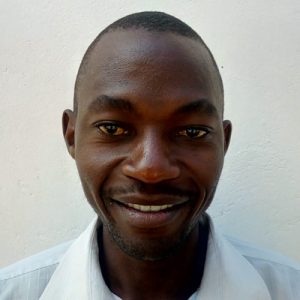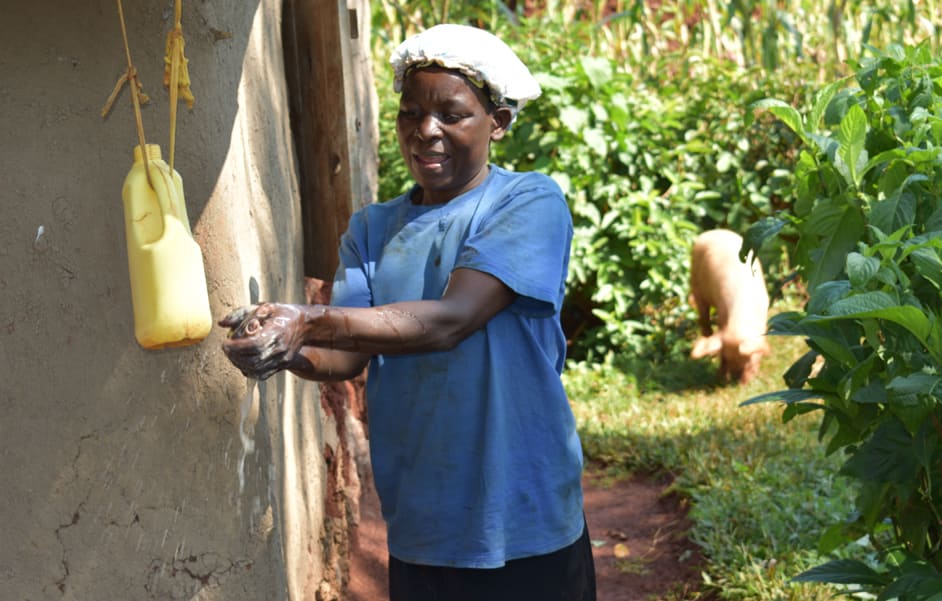July, 2020: Through Their Eyes: COVID-19 Chronicles with Simon Mulongo Musungu
This post is part of a new series by The Water Project meant to highlight the perspectives and experiences of the people we serve and how the COVID-19 pandemic is impacting them. We invite you to read more of their stories here.
68-year-old farmer Simon Mulongo Musungu lives in Busichula, Kenya, where he relies on protected Marko Spring for his daily water needs.

Simon greeted Lynah outside his home in Busichula.
Our team recently visited Busichula to conduct a COVID-19 prevention training (read more about it below!) and monitor their water point. Shortly after, we returned to check in on the community, offer a COVID-19 refresher training, and ask how the pandemic is affecting their lives.
It was during this most recent visit that Simon, who also serves as the Committee Advisor to the Marko Spring Water User Committee, shared his story of how the coronavirus has impacted his life.
Programs Officer Lynah Akuku met Simon outside his home to conduct the interview. Both Lynah and Simon observed social distancing and other precautions throughout the visit to ensure their health and safety. The following is Simon's story, in his own words.
"Since the installation of Marko Spring, the number of people using the water at the spring has increased, but luckily the spring has 3 pipes, so crowding is not there as before. Having a clean water point has helped me a lot because now l can access safe, clean drinking water without fear of getting infected by the coronavirus.

Simon fetches water from Marko Spring.
COVID-19 has impacted my family in a big way. Now, my children and grandchildren are not going to school, and they can't access the internet where they can learn from because I cannot afford it. Those who are working - they are not able to go to work, thus making it difficult to provide food for their families. Some have lost their jobs, and I have other children who are working in various counties away from Kakamega County; they cannot come home because of restrictions in movement, making me miss them.

Simon (left) with his son (third from left) and 2 grandchildren at home
I used to sell cows by being the middle man between the buyer and the seller, and I would get a little commission. I would get the type of cows requested from people's homes and bring them to the cattle market during market days. Now since the pandemic, I cannot move about to undertake my job because of restrictions. The market where this used to happen has also been closed down. Now it is difficult for me to provide for the family.
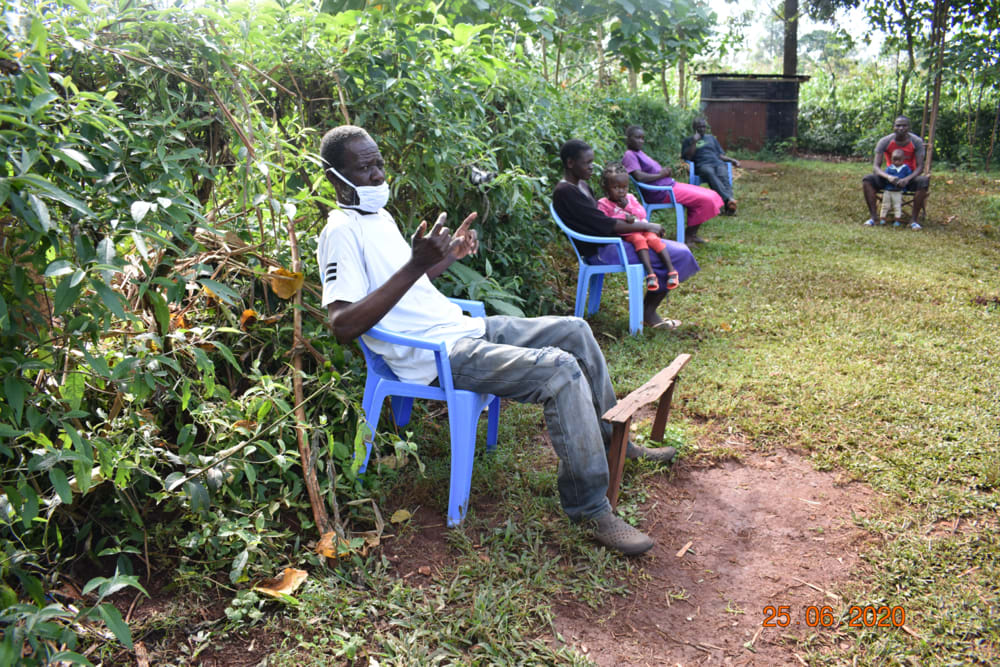
Simon actively participates in the COVID-19 refresher training held on the day of his interview.
After the COVID-19 training from your team, l have been observing the 1-meter rule when fetching water at the spring, unlike before. Even when going to the spring, I have to wear a mask because I will meet people there.

Community members observe social distancing while lining up behind Simon to fetch water at Marko Spring.
Measures that I have taken to stop the spread of the virus are observing social distancing in any social gathering; making sure I wash hands as many times as I can with water and soap; wearing of masks whenever I leave my home, but If I have nothing to do I stay at home. As a community, we are avoiding crowds, and if we attend burials, we only stay for half an hour and leave as this is the government policy.


Simon washes his hands using the leaky tin handwashing point he installed outside his home.
I desire that schools will reopen because the students are already losing a lot while at home. However, I would propose that when schools open, students and teachers should report to the schools that are closest to them and avoid traveling to their current schools if they are already outside their respective counties to avoid the spread of the virus since numbers [of cases] keep on increasing daily."

Simon shows his homemade mask.
When asked where he receives information on the coronavirus, Simon listed the radio, television, word of mouth, loudspeaker/megaphone announcements, the training he attended from our team, and through short messages by phone, which are being sent by some mobile subscribers.

Simon puts on his mask.
"The most helpful part l have received through your team's COVID -19 sensitization is to be careful how l carry myself when moving in and outside the compound, making sure to adhere to the precautions. I had construction in my compound, and l emphasized to the workers to adhere to precautions such as maintaining social distance, wearing masks at all times, avoiding handshaking, and washing hands at all times. All this knowledge I received from the sensitization by The Water Project."

Simon wearing his mask
"Before the COVID-19 sensitization, Busichula community members were not serious about the coronavirus, and they were doing things normally. But after the sensitization from our organization, they have observed precautions for their own safety. For example, washing hands, avoiding handshaking, observing the 1-meter rule, and avoiding social gatherings like funerals. They were so excited, and they thanked us for creating awareness for them." - Programs Officer Lynah Akuku

May, 2020: COVID-19 Prevention Training Update at Busichula Community, Marko Spring
Our teams are working on the frontlines of the COVID-19 pandemic. Join us in our fight against the virus while maintaining access to clean, reliable water.

Team Leader Emmah (center) heads the training
We are carrying out awareness and prevention trainings on the virus in every community we serve. Very often, our teams are the first (and only) to bring news and information of the virus to rural communities like Busichula, Kenya.
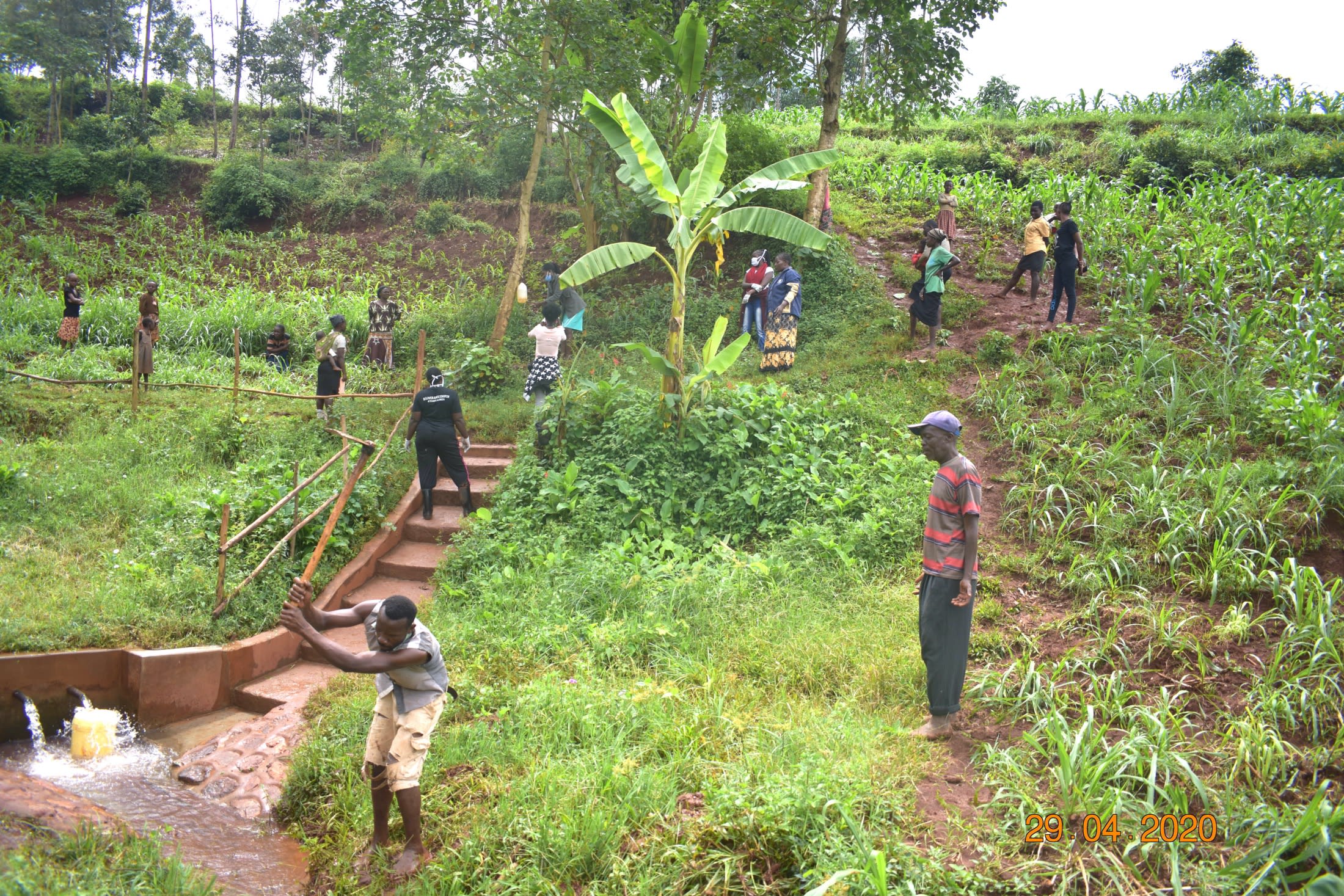
Background: Community members observe social distancing as a requirement of attending training; Foreground: a man clears the spring's drainage channel
We trained more than 15 people on the symptoms, transmission routes, and prevention of COVID-19. Due to public gathering concerns, we worked with trusted community leaders to gather a select group of community members who would then relay the information learned to the rest of their family and friends.

Trainer Protus fills the leaky tin handwashing station with water
We covered essential hygiene lessons:
- Demonstrations on how to build a simple handwashing station
- Proper handwashing technique
- The importance of using soap and clean water for handwashing
- Cleaning and disinfecting commonly touched surfaces including at the water point.

Trainer Lynnah demonstrates the 10 steps of handwashing
We covered COVID-19-specific guidance in line with national and international standards:
- Information on the symptoms and transmission routes of COVID-19
- What social distancing is and how to practice it
- How to cough into an elbow
- Alternative ways to greet people without handshakes, fist bumps, etc.
- How to make and properly wear a facemask.

A community member washes her hands
During training, we installed a new handwashing station with soap near the community’s water point. Due to the rampant spread of misinformation about COVID-19, we also dedicated time to a question and answer session to help debunk rumors about the disease and provide extra information where needed.

Making sure to get under the fingernails during handwashing
We continue to stay in touch with this community as the pandemic progresses. We want to ensure their water point remains functional and their community stays informed about the virus.

Trainers demonstrate social distancing while fetching water at the spring
Water access, sanitation, and hygiene are at the crux of disease prevention. You can directly support our work on the frontlines of COVID-19 prevention in all of the communities we serve while maintaining their access to safe, clean, and reliable water.

February, 2020: Busichula Community, Marko Spring Project Complete!
Busichula Community now has access to clean water! Marko Spring has been transformed into a flowing source of water thanks to your donation. We protected the spring, constructed 5 sanitation platforms for different households in the community, and we trained the community on improved sanitation and hygiene practices.

Community members enjoying the new spring
Spring Protection
Community members provided all locally available construction materials, including bricks, wheelbarrows of clean sand, stones, and fencing poles. Accommodations and meals were provided for the artisan, too.

Kids help carry rocks to the spring construction site
At first, there were some delays in gathering the required materials from the community as the spring has a big catchment area that needed a lot of large stones for the backfilling process, but through a lot of hard work and determination, the community was finally able to gather them together.
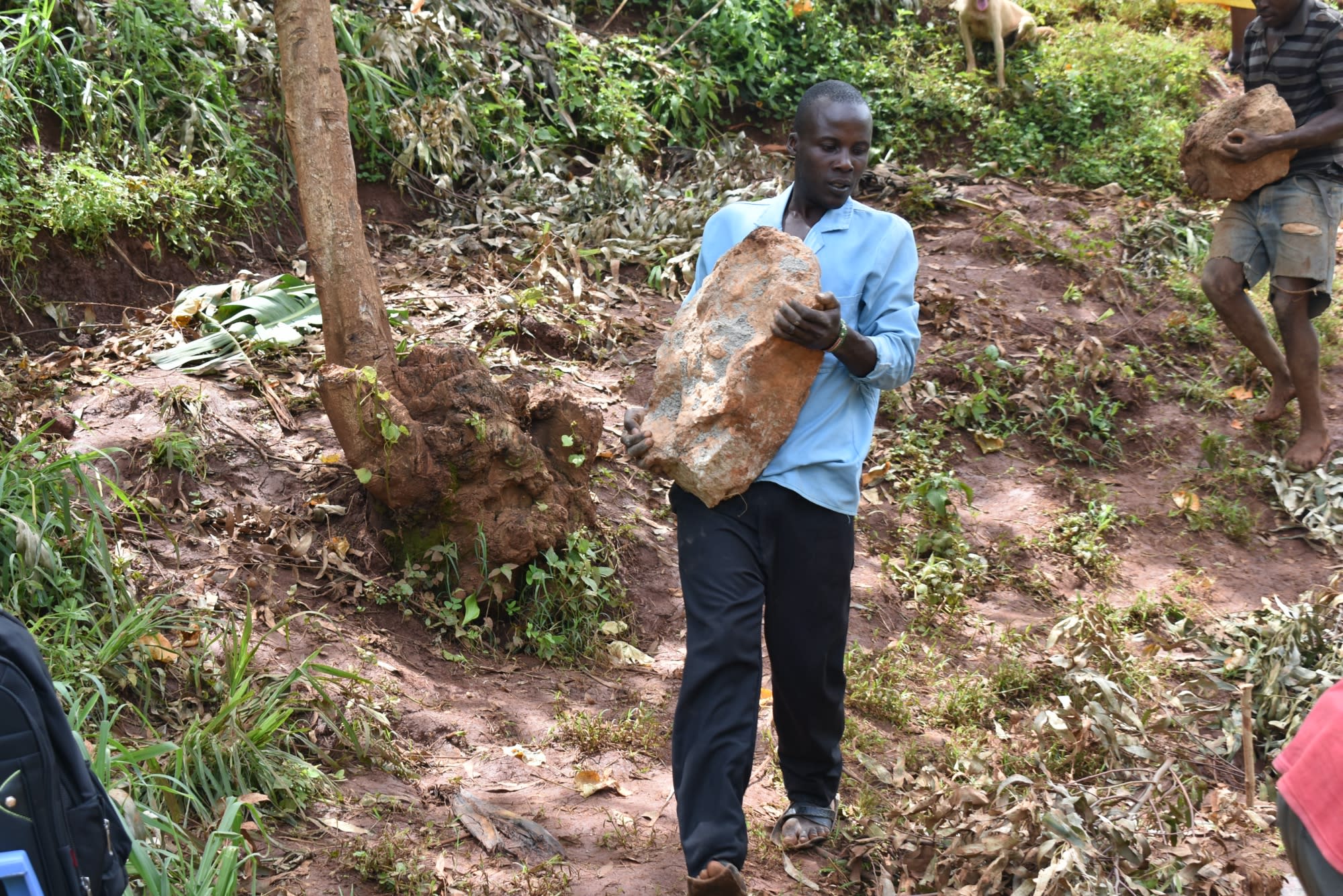
Adults carry the larger rocks to the construction site
They had to carry each stone to the construction site by hand, just like the rest of the materials, but they persisted to get the job done.
The Process
Women and men lent their strength to the artisan to help him with manual labor. The spring area was excavated to create space for setting the foundation of thick plastic tarp, wire mesh, and concrete. After the base had been set, both wing walls and the headwall were set in place using brickwork. The discharge pipes - 2 in this case due to the spring's naturally high yield - were fixed low in place through the headwall to direct the water from the reservoir to the drawing area.

Artisan measures first brickwork over spring's concrete foundation
As the wing walls and headwall were curing, the stairs were set and ceramic tiles were fixed directly below the discharge pipes. This protects the concrete from the erosive force of the falling water and beautifies the spring. The process of plastering the headwall and wing walls on both sides reinforces the brickwork and prevents water from the reservoir from seeping through the walls and allows pressure to build in the collection box to push water up through the discharge pipes.

Cementing the discharge pipes into the headwall
The source area was filled up with clean stones and sand and covered with a thick plastic tarp to prevent potential sources of contamination. The only ongoing challenge during construction was the ongoing short rainy season, as it rained every day from 1:00 pm until evening. This also caused some delays to the work, but the artisan and his work team were used to the weather pattern and were able to plan around it to get their work done on time.

Artisan plasters the rub walls
It took about 2 weeks of patience for the concrete to dry. As soon as it was ready, people got the okay from our field officers to begin fetching clean water. We met them there to celebrate this momentous occasion.
"How wonderful a day it was," reflected Field Officer Lynnah Akuku, the lead field officer for this project. During the handing over of the project to the community, Marko Spring members gathered together with happy faces, thanking our team for protecting their spring.

Officially handing over Marko Spring to Busichula community members
They expressed that they used to take unclean water but now that the spring is protected, they will be able to access clean water within just a few minutes. They also expressed their hope that now, premature death due to waterborne diseases will be a thing of the past. The community members were very happy, singing all sorts of wonderful songs and dancing while continuing to thank the organization so much. (To hear them for yourself, check out the video on the Photos tab of this project page!)

Celebrating the new spring
"Thank you The Water Project for the good work and for remembering us. May God bless you so much wherever you go," said village advisor Hillary Harambee.

A woman gives thumbs up for clean water from Marko Spring
"Before the protection of the spring, we were fetching unsafe water for drinking because the spring was open," reflected community member and farmer Mr. Stephen Shihemi.
"After the completion of the spring, I came here and l was very impressed with what l saw. The spring has a new look and it is easy to access quality, clean, and safe water for drinking. I thank The Water Project so much for remembering us," he said.

Women join hands over clean, accessible water
Sanitation Platforms
All 5 sanitation platforms have been installed. These 5 families are happy about this milestone of having a private latrine of their own and are optimistic that people will no longer leave waste outdoors. We are continuing to encourage families to finish building walls and roofs over their new latrine floors.

Proud new sanitation platform owners
New Knowledge
Village advisor Hillary Harambee was tasked with organizing the training. She gave us the community’s preferred date for training, for she was very much aware of the community calendar when it comes to planting season and other big events.
27 people attended training, which was a great turnout. All of the participants were eager to learn and hear from us. Since the training took place on a Saturday we also had children included in the training and they were so happy for the training and to see spring construction.
(Most of these pupils attend Shiyikha Primary School, so many of the topics were familiar to them already!).
We also had 2 Community Health Volunteers in attendance.

Team Leader Emmah Nambuye Wekesa kicks off training
Since it was a sunny day, the training was conducted near Marko Spring under a tree. The community members were very happy throughout the day. Some members from other communities also attended the training because of what they saw concerning spring protection and they wanted to know more about the project.
We covered several topics including leadership and governance; operation and maintenance of the spring; healthcare; family planning; immunizations; and the prevention and spread of disease. We discussed water treatment methods, personal care like handwashing, environmental hygiene, hygiene promotion, and many other things. Community members also decided to start some income-generating activities that will improve their living standards after brainstorming on the topic.

Children carry grass to be planted at the spring
After training the community members about site management at the spring, the participants together with all of our team members present took the initiative to fence the site around the spring while planting grass over the spring box to avoid erosion. The community members also participated in digging the drainage channel that will divert runoff from above the spring to down below it and into the stream to ensure safe access to the protected water point through all seasons, regardless of the weather. This drainage channel had particular energy behind it as a child had already drowned in the overflowing spring during a previous rainy season. The community was motivated to keep every person who might try to fetch water safe at all times going forward.

Community members help dig the cut-off drainage channels to redirect uphill runoff away from the spring
The participants were particularly excited to know more about handwashing because those who had been practicing it had been doing so without following the steps, and some participants were at first sure that handwashing was not even necessary to one's health. We went over the critical times to wash their hands, such as after visiting the latrine or changing a baby's diaper, before preparing food, and before eating. The community members were very excited to learn new things in this lesson.

Handwashing practical during training
Many said their children are always sick, not knowing that one of the main causes could be because they have not been washing their hands before eating. The group was very excited to learn that handwashing can help reduce illnesses and save money for other things and by doing that, help them to improve their standard of living standard. During the demonstration process, they were so happy practicing and repeating the 10 steps. The entire training group promised to improve on this practice and start washing their hands daily.

A woman washes her container before catching water, a practice we taught during training
"We have been taking water just like that [without worrying about its sanitation] but through this training, it will help us to improve on our sanitation and hygiene behavior. I believe that our lives will change and we will improve our standard of living because of it," said Nancy Naliaka, a businessperson from the community.
Thank you for making all of this possible!


 Protected Spring
Protected Spring
 Rehabilitation Project
Rehabilitation Project










